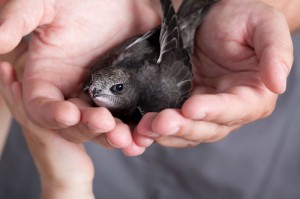Everything You Ever Wanted To Know About Chimney Swifts
Any bird watcher who spends time watching the sky has most likely noticed chimney swifts from time to time. Even those who do not have a particular interest in birds may be familiar with the species if the birds have set up camp in their homes. Although some may view having them in the chimney as a nuisance, they are actually quite beautiful and interesting birds. They deserve attention now more than ever, as they are listed as a near threatened species. Under the Migratory Bird Treaty Act it is illegal to destroy the nests of these birds. Certified sweeps are aware of the law and experienced with this species.
One defining feature that makes the chimney swift so interesting compared to other birds is that it spends almost all of its life airborne. These unique birds cannot perch like other species do, so they cling to vertical walls. They may find a place to rest in a chimney or a hollow tree, which is where they got their name. Since chimney designs have changed in recent years, it is more difficult for them to find a place where they can fit and rest safely. Sometimes the birds cannot grip the metal flue pipes and fall into the fireplace This contributes to the near threatened species of these birds. Don’t try and remove the birds from the chimney yourself. Call a certified sweep to humanely remove the birds.
Chimney swifts are typically found on the outskirts of urban and suburban areas. The array of trees makes it easy for the birds to forage for their food of choice, which are insects. These areas also provide many options for the birds in terms of places that they can rest. They typically have their pick of narrow, vertical spaces, including chimneys, wells, caves and even air vents. Using a chimney cap disallows the birds from setting up camp in your chimney.
This species is easily identified by its small, slender body as well as by its narrow wings. It has a small bill that is so short; people often have difficulty seeing it at all. The small body is a dark grayish brown color, but it appears to be completely black when viewed against the light of the sky. Once these birds have found a resting spot, they tend to return to it year after year. Again, a sweep can remove any debris left by these beautiful birds.
In addition to their unique body type, chimney swifts can be identified by the unique ways in which they move. Since they are airborne nearly one hundred percent of the time, they move their wings constantly at a very rapid speed. When their bodies move, it is in a very rigid style, allowing them to glide quickly through the air. They have an easily identifiable call, which is high pitched and sounds somewhat like chatter.
Anyone who has had these birds in their chimney knows that you will rarely find just one of them in a space. They tend to roost in colonies with several birds in one chimney or hollowed out tree trunk. They are set apart from many other species in that they live this way even outside of their typical mating season. Chimney swifts also help humans out — a two parents and their offspring can ingest up to 12,000 flying insects every day.
Although they are quite unique, these birds are often confused with a few other species. For example, they look similar to the Vaux swift but the birds differ in their mating patterns. The cliff and tree swallows also look similar but a trained eye will realize that their bodies are not exactly the same. The swallows have wings with a more triangular shape and tend to be more fluid in their motion than the rigid swifts.
Many average people are familiar with chimney swifts because they have found them in their own chimneys. However, bird enthusiasts know that these birds are extremely unique and interesting in a number of ways. Since chimneys are not used as often today and, when they are, are built in small, narrow shapes, the species is on the decline. It is important to learn about these birds and their habits in order to protect them from extinction. Remember, if you have swifts in your chimney, don’t try and remove the nests yourself. Hire a professional chimney sweep to make sure the removal is harmless for the birds and that your chimney is cleaned for optimal safety and efficiency.

